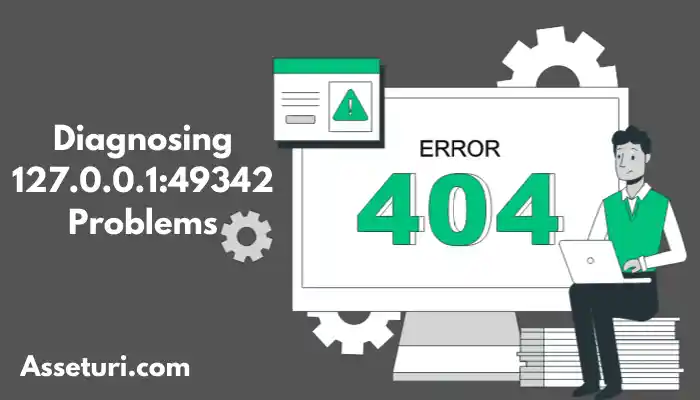Understanding 127.0.0.1:49342 Connection Errors
Newcomers and experts may find the error “127.0.0.1:49342” unsettling and perplexing. Usually, it indicates a software or system issue, but it is not concerning. This article can help you find and resolve these problems.
127.0.0.1 and other loopback ports are vital to remote computer interaction. Issues with particular ports, like 127.0.0.1:49342, can lead to errors in many tasks, like server setups and web development. The problems must be recognized and solved for everything that’s operating correctly.
This guide explains a quick, easy method for identifying and resolving 127.0.0.1:49342 issues. We’ll help you recognize the signs, pinpoint typical reasons, and offer viable solutions. It gives you the skills and confidence to take on matters concerning 127.0.0.1:49342 and fix the system, despite your technology skills.
What are Error Codes?
Error codes are how computers tell us something’s wrong, using cryptic mixes of numbers or letters. They cover everything from minor typos to significant system breakdowns, acting like a tool to find problems.
Codes like 127.0.0.1:49342, 127.0.0.1:62893, Tex9.net, and Tex9.net Crypto, etc., give detailed information about errors in software or systems, helping users and techs spot issues quickly and fix them right. Knowing how to read error codes is critical to solving problems effectively. By finding the issue, you can resolve it and return it to the norm.
What is 127.0.0.1:49342, and Why Does it Matter?
As an error find “127.0.0.1:49342” arrives, this indicates an error with the IP address (127.0.0.1) and port number (49342) in your computer’s localhost setup. The port number serves as a link for data flowing to a particular service or usage, while this IP address serves for interactions inside apps on your system. Problems with this combination often come from software bugs, network setup issues, firewall restrictions, or conflicts with other applications using the same port. Understanding these factors is crucial for fixing “127.0.0.1:49342” errors, which is essential for keeping your local network running smoothly and debugging software.
Common Causes of 127.0.0.1:49342 Errors
Here’s what commonly triggers 127.0.0.1:49342 errors:
- Software Issues:
– Failed installations or updates.
– Application crashes disrupt network connections.
- Network Problems:
– Firewall misconfigurations.
– Router or modem issues.
– ISP connectivity disruptions.
- System Challenges:
– Malware interference.
– System file corruption.
– Hardware failures affecting network adapters.
Diagnosing 127.0.0.1:49342 Problems

Having trouble with 127.0.0.1:49342? Here’s how to diagnose the problem:
- Identify the Application: Check running processes and installed software to see if anything uses port 49342.
- Verify Network Connectivity: Scan localhost (127.0.0.1) to verify access and check your internet connection.
- Inspect Firewall Settings: Ensure your firewall isn’t blocking port 49342.
- Review Software Configuration: Check application settings and consider reinstalling the app if necessary.
- Check for Port Conflicts: Use “Netstat” or similar tools to find any conflicting processes using port 49342.
- Review System Logs: Review system logs for error messages concerning 127.0.0.1:49342.
- Consider Malware: Use an antivirus program to detect viruses that cause problems.
Effects of 127.0.0.1:49342 on Various Apps and Systems
If 127.0.0.1:49342 is down, it may mess with some critical areas:
Development and Testing: It affects local server setups and software testing environments.
Networking and Servers: Internal network operations and server configurations can be disrupted.
Security and Firewall Settings: It may lead to firewall blocks and pose security risks.
Overall System Performance: Strains on resources can impact user experience and system stability.
Resolving these issues on time ensures smooth system operation and user satisfaction.
Step-by-Step Guide for Fixing 127.0.0.1:49342 Errors in Details

Evaluating “127.0.0.1:49342” is vital as it often implies a problem with an app or activity on your desktop system (localhost). “49342” denotes a specific port used for interaction.
-
Identify the Application or Service:
– Check which processes use port 49342 using Task Manager (Windows) or Activity Monitor (macOS).
– Look into recently installed or updated software that might be causing conflicts.
-
Check for Software Updates:
– Ensure all applications, especially the one using port 49342, are updated to prevent network-related bugs.
-
Verify Network Connectivity:
– To make sure that your web link runs appropriately, test it.
– To verify local network access, type `ping 127.0.0.1} into a terminal or command line.
-
Inspect Firewall Settings:
– Turn off your firewall to see if it’s blocking port 49342.
– If disabling resolves the issue, create a rule allowing the application access through the firewall.
-
Examine Software Configuration:
– Review the application’s settings to ensure no incorrect network configurations.
– Check that the application has the necessary permissions to operate correctly.
-
Check for Port Conflicts:
– To determine if another process uses port 49342, you can use tools like netstat (Windows) or lsof (Linux/macOS).
– Resolve conflicts by either changing the port used by the application or terminating the conflicting process.
-
Verify System Logs:
– Look for errors relating to 127.0.0.1:49342 in system logs (Event Viewer on Windows, Console on macOS).
– Be alert of specifics in the logs as they get hints concerning the issue.
-
Consider Malware Interference:
– To detect malware disrupting the network, run a basic scan of your system using an antivirus program.
-
Restart Your Computer:
– Sometimes, restarting your computer can resolve temporary glitches affecting port 49342.
-
Seek Professional Help:
If you’ve followed these steps without success, Contact technical support for more help with the application or your computer system.
You can ensure the system and software run smoothly by identifying and solving errors seen to 127.0.0.1:49342.
Read More: https://asseturi.com/insights-into-127-0-0-162893-what-does-it-mean/
Essential Troubleshooting Tools
To effectively troubleshoot various issues, you can rely on these fundamental tools:
1. Basic Command-Line Tools:
Ping: Checks if a host is reachable over a network.
Traceroute/Tracert: Maps the path data takes to reach its destination.
Ipconfig/Ifconfig: Displays network configuration details like IP addresses.
Nslookup: Queries DNS servers for domain name or IP address information.
Netstat: Provides information about network connections and statistics.
2. Network Analysis Tools:
Wireshark: Captures and analyzes network traffic for detailed inspection.
Nmap: Analyzes networks to detect security vulnerabilities and discover devices.
MTR: Combines ping and traceroute capabilities to diagnose network issues comprehensively.
3. Operating System Tools:
Task Manager (Windows) / Activity Monitor (macOS): keeps track of all active tasks, resource use, and system activity.
Event Viewer (Windows) / Console Logs (macOS/Linux): Logs system events and error messages, aiding in troubleshooting and diagnostics.
Advanced Troubleshooting for Complex 127.0.0.1:49342 Issues
Innovative techniques help if basic troubleshooting fails to fix “127.0.0.1:49342” errors. These involve:
- Thoroughly analyzing application dependencies to spot conflicts.
- Tools like Wireshark are used to monitor network traffic.
- Utilizing detailed logs for debugging.
System diagnostics and environmental checks are vital in addressing complex problems and ensuring applications and network services run smoothly.
Prevention Tips for Future 127.0.0.1:49342 Problems

To avoid future “127.0.0.1:49342” issues, ensure your software is constantly updated, set up firewalls correctly to manage port access, regularly monitor your network, and maintain system health by backing up data and performing disk cleanup. Install software safely, educate users about security practices, keep thorough documentation of configurations, and adhere to best practices for stable system operations.
Conclusion
With the right tools and awareness, the 127.0.0.1:49342 problem can be resolved, although it seems complex. Through troubleshooting techniques and root cause analysis, users can access the system for average performance. Prevention is key, so maintaining good software management and network security practices improves the digital experience. Despite error correction, the critical parts of fixing 127.0.0.1:49342 involve diagnostics and speed optimization. Mastering programs like Task Manager, Ping, and Wireshark enables efficient detection and resolution of system and network issues, ensuring optimum efficiency and easy operation.
FAQs
Does 127.0.0.1:49342 occur due to a virus?
Errors such as 127.0.0.1:49342 might be due to malware blocking networks. For this reason, a complete antivirus check is essential.
Is there specific software that often triggers 127.0.0.1:49342 issues?
While any software using port 49342 can cause issues, gaming platforms, file-sharing software, and remote access tools are more prone to network problems.
Can hardware problems lead to 127.0.0.1:49342 errors?
Network adapters, routers, or other hardware issues can disrupt local connections and trigger errors. Check for physical damage, loose connections, or outdated drivers.
Should I contact my ISP if I’m experiencing 127.0.0.1:49342 issues?
If other causes are ruled out, ISP-related problems could affect local network connectivity. To learn about local internet downtime or issues, consider contacting your ISP.
In the future, how can I prevent 127.0.0.1:49342 errors?
To prevent these errors, regularly upgrade your network operator’s apps and OS system. Use antivirus software, keep your router sturdy, and perform regular backups.
Click Here to read more about Asseturi.














Post Comment